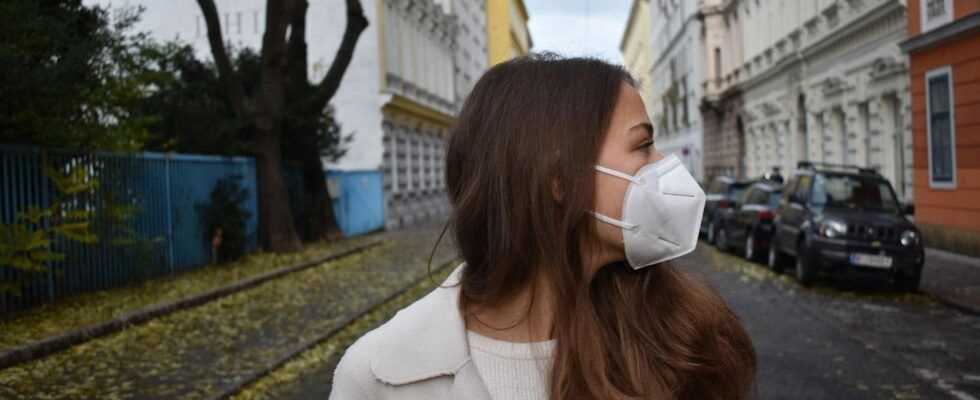Corona current
5 things you need to know about FFP2 masks
© Sags-FRIEDA / Shutterstock
If FFP2 masks should become compulsory, questions suddenly arise: How long does the face mask last? What do I have to consider with FFP2 masks? Where can i get it from?
You see them more and more often on the street, in the first federal state they are already mandatory in shops and means of transport: FFP2 masks are increasingly accompanying us through the corona pandemic.
After the surprising FFP2 mask requirement in Bavaria, its expansion to all of Germany is now up for debate. Mainly because the corona numbers are still at a high level. But even if the masks are supposed to guarantee better protection for yourself and others, they still contain some pitfalls – both in use and already in sale. We clarify a few things you should know about FFP2 masks.
FFP2 masks: 5 questions, 5 answers
Where can I get the FFP2 masks from?
At the beginning of the corona pandemic, they were completely sold out, but now shops assure that they have purchased sufficient supplies. You can get FFP2 masks in pharmacies without any problems – however, they are usually still quite expensive and cost around five euros each.
In December, pharmacies already issued three masks per person to the risk group, this service currently no longer exists. Instead, the health insurance companies should now send coupons for FFP2 masks to people aged 60 and over and those with previous illnesses by post. Then you should get six masks twice and only have to pay two euros each. Shipping is currently still slow.
Fake? You have to pay attention to these characteristics
It is important to pay attention to the labeling when buying. There are currently warnings against counterfeits and masks with reduced protective effect. The Federal Institute for Drugs and Medical Devices points out the CE mark and number that should be embossed on the outside of the FFP2 mask. The "CE" may only be printed if the product has been tested according to the specifications of the European standard "EN149: 2001 + A1: 2009". This includes, for example, the requirement that the filter performance must be at least 94 percent. If you are unsure, you should ask explicitly about the test in pharmacies.
How safely do FFP2 masks protect? How do I wear FFP2 masks for the best protection?
FFP2 masks promise a filter performance of 94 percent, i.e. they must be able to filter 94 percent of the test aerosols. The FFP2 masks primarily serve to protect the wearer, without a valve they also protect others. According to the BfArM, protection is only guaranteed if masks are worn correctly: "They have to sit close to the face in order to be able to develop their filter performance," writes the Federal Institute. The mask should therefore neither stick out from the nose nor the chin, but lie directly against it – at the same time, a beard can already reduce protection, as several experts are now warning.
Are valve masks just as safe?
No. The Federal Institute expressly points out that FFP2 masks with a valve make breathing easier for the wearer and do not impair their protection – but endanger the environment: "Exhaled aerosols are not intercepted by the filter material, but only slowed to a certain extent by the valve and swirls. " The internal and external protection of 94 percent is only ensured by FFP2 masks without a breathing valve.
Can I clean FFP2 masks? If yes how?
Actually, the FFP2 masks are expressly intended for single use. However, a federally funded research project at the University of Applied Sciences and University of Münster is currently running. It should be examined how the protective effect can be maintained despite multiple use in private use. There are currently two options to choose from in the information flyer:
- Drying the FFP2 mask in room air for seven days is intended to minimize the risk of infection. After seven days, the infectious particles should have reduced by 95 percent. To do this, the researchers recommend hanging seven nails on the wall at a sufficient distance to dry the masks. The checkmarks can be marked according to the day of the week. The face of the mask should not be touched when it is removed and the mouthguard should hang on the hook for at least seven days before it is used again. Important: You should not hang up in the kitchen or bathroom, as there is higher humidity here. And: Even then, each mask should only be worn once, then dried for seven days and only used five times in the drying cycle – then it belongs in the trash.
- The second method recommended is disinfectant drying at 80 degrees. "With the" dry heat 80 ° C for 60 minutes "process, SARS-CoV-2 can be completely inactivated," writes the Münster University of Applied Sciences. However, there are a few things to consider here too: Each wearer should only use their own mask, so products should be labeled when they are drying at the same time. In addition, the FFP2 mask has to hang out in the air for a day before it goes into the oven. This should be preheated before the masks are pushed in on a grate lined with baking paper and the oven is not opened in the meantime. Then the masks need to dry for 60 minutes. Another problem lurks here: The temperature should be 80 degrees with top and bottom heat. Since ovens fluctuate, a thermometer is recommended. The same applies to this variant: The FFP2 mask may not be reprocessed in this way more than five times, and it is not suitable for dimensionally stable masks and valves.
Sources used: Federal Institute for Drugs and Medical Devices, Umschau pharmacies, Der Spiegel, Münster University of Applied Sciences
